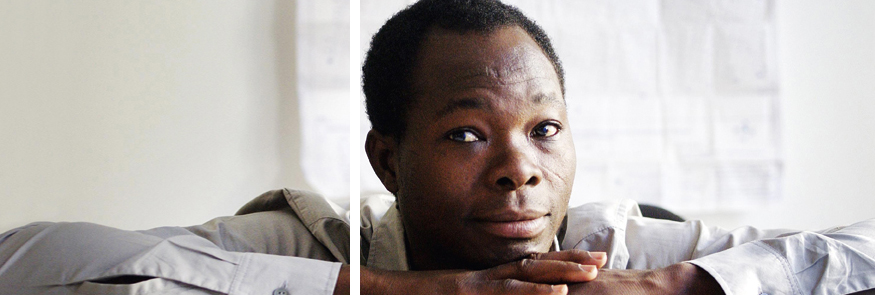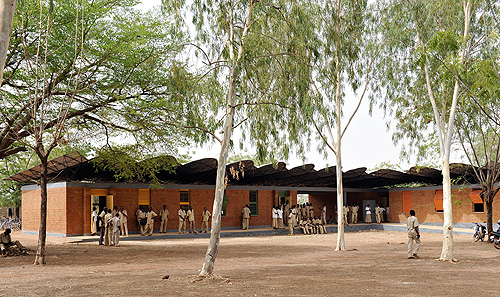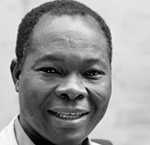Of bridges and schools
Francis Kéré combines European expertise with African tradition.

African architect Diébédo Francis Kéré is guided by a simple idea: making buildings that are purposeful and unwasteful, good for the people who use them and appropriate to the local circumstances. To put this idea into practice he crosses boundaries, traditions and cultures, working in close dialogue with the people involved. This makes architecture, as he practices it, a kind of socially responsible cultural mediation.
WHEN FRANCIS KÉRÉ became one of the first from his village to go to school, many people thought the chief’s son would be lost to the village forever. They said to themselves: “The chief is sending his oldest son to school. Who will help him and us with the work in the fields now?” To the astonishment of his village, Kéré went not just to school but even further than this: After completing his school studies he won a scholarship to study architecture in Germany. Yet instead of being lost to his village forever, he came back – with Western European know-how and architectural techniques, with a new view of his country and his cultural roots, and with an idea: the idea of building a school made of clay in his home village of Gando.
Small project with a big impact
Initially the villagers responded with some skepticism to his idea. Clay was certainly free and available in vast quantities – but experience had taught them that it would not last more than one rainy season. What they visualized was the kind of concrete building the French occupying forces had put up in Africa. Even his fellow students in Berlin were not overly impressed by his clay hut project, and tended to smirk when he explained his ideas to them. For them the idea of harnessing European knowledge in order to modernize African huts seemed simplistic and architecturally undemanding.
Yet Kéré was not to be deterred. He spoke with the people of his village about the technical possibilities and what the buildings needed to do; he improved the basic material, clay, by adding cement to it; he trained the local people so that they could develop and assemble the building and the necessary materials themselves and created a form of architecture which is still educational in every sense of the word to this day. Ten years after it was first put up, the building – now supplemented by teachers’ houses – is still being used as a school, its construction method and the cross-cultural story of its evolution have been proposed as subjects for doctoral theses, and Kéré was recently presented with the high-profile Swiss Architectural Award for the project’s exemplary character. More than almost anybody else, Kéré is internationally regarded as a pioneer of sustainable architecture – architecture appropriate to local ecological and social requirements, uniting diverse approaches across boundaries of tradition and culture.
Dialogue with people
Yet what makes his architecture unique is not just the composition of the finished building, in which modernity and tradition, new and old materials, Europe and Africa meet and merge in new formal and physical combinations. Nor it is simply Kéré’s responsible approach to the resources needed to build and operate his buildings. What is even more remarkable is the dialogue his works generate in their local environment. It is the way he involves people, the way Kéré the architect allows his works to speak for themselves – the way he listens, coordinates, picks up ideas and enables something new to emerge from long and intensive discussions; the way he forges a fruitful correspondence between his European technical knowledge and expertise and the local materials and cultures.
Does he see himself as a bridge-builder, a mediator between two worlds? The question makes him pause before, with modest words, Kéré explains that his way of combining European expertise with African tradition does not follow a premeditated plan, but “simply came about in this way”. He tried, he says, to take what he had learned in Europe and make it useful for his community in Gando: “At university I learned the best way to build a building so that it stays standing. I went to my home village with this knowledge and thought about how this could be done in a place where most people neither read nor write and so could not understand architectural plans.” As a result he started talking to the local people, talking to them for a long time until finally – as he puts it – “the original idea was fully formed”.
Kéré describes vividly and tangibly how important it is that this dialogue is conducted on an equal footing: “I sit down on the ground, just like the people of my village, Gando, and we talk for a long time. I’m not someone who is introduced with an interpreter, who comes with a big car and commands respect. I am not a guest they’re afraid of offending, because they don’t know his culture. They talk to me openly and so the dialogue produces results of substance. This is the work I do. If this interchange is seen as bridge-building it’s not something I have planned but basically this is something I’m very happy about.”
“An open dialogue produces results of substance. This is the work I do.”
Even for African-born Kéré there are, he says, considerable challenges to be overcome in conducting a productive conversation with people who cannot read or write and who do not necessarily grasp connections instantly. Initially he had to put all his science and technology, his European way of thinking, to one side and focus wholly on the people. But, he continues enthusiastically: “If you manage to overcome this hurdle, to throw off the cultural ballast, if you take time, then you discover the potential that exists there and you realize that an idea produced by science can be enriched by the experience of these people.” Their poverty in economic and scientific terms is offset, he says, by other kinds of wealth – centuries of working with nature, for example. Anyone who wants to work successfully with people in Africa must know two things, says Kéré: They must not awaken false hopes and they must be ready to learn from them. Local people knew better than any expert, for example, that it was not a good idea to put a building in a dried-up river bed – no longer recognizable as such – because one day the waters would return and carry away everything in their path.
A subject Kéré specifically wants to address is the interchange between Africa and Europe. “There are certainly convergences,” he says, but people are still trying to make the African continent into a second Europe. “We are importing European ideas and models instead of learning from Africa.” How can a serious interchange between partners come about, he asks, when the African continent is given no time to have its own experiences and make its own mistakes? Can a continent adopt European models of democracy and party systems from one day to the next – models which only took shape in Europe over the course of many centuries?
Learning from Africa
A genuine interchange, he emphasizes again and again, means that both sides are able to present and contribute their own culture. Kéré still remembers how after just a few weeks in Germany he was so enthusiastic about his European experiences that he began to undervalue his African culture. And so he joined in “the chorus of sweeping judgments about the primitive nature of African countries” and was convinced that it was necessary to export European achievements to Africa. The European education system had particularly impressed him: compulsory school attendance was not just a theoretical requirement but was backed up by the provision of appropriate institutions. At some stage his view changed, however, and he re-assessed his roots, reaching a new understanding of both the weaknesses and the strengths of his continent. Kéré recalls the wisdom and the implicit knowledge that are transmitted from generation to generation in Africa without institutions, and he talks about the German students who work term after term and take one examination after another – all under enormous time pressure. In the process, he observes, they lose the courage to move into new areas, to test simple ideas, or to go abroad for a few months.
“Learning from Africa” is the guiding motto of an architectural project which has made Kéré famous far beyond architectural circles. Kéré was commissioned by the theatre director Christoph Schlingensief, who died recently, to turn his idea of creating an opera village in Burkina Faso into a reality. Schlingensief was already very ill when he approached Kéré with this project, asking him to support it as an architect and as a cultural mediator. The key aspect of this realization was not to be the implementation of a predetermined design – instead, Schlingensief wanted to give an idea space and time to take effect. Kéré calls this “allowing an idea to take shape slowly, based on its effect”. For Kéré the opera village “turns on its head everything previously done in the field of development aid.” Schlingensief’s idea, he says, is “an idea that builds bridges”: many people in Africa and from Europe want to be involved in it, whether as artists, architects or development workers. The result is not an opera house on the European model but a “place of self-help”, a “place of exchange”. Here as in other works by Kéré none of the technologies or materials are imported: everything is produced locally from locally available materials, with the help of the local population. Schlingensief borrowed the Beuys concept of “social sculpture” to describe this approach: the people are not simply building an opera house but learning to build workshops and to use building materials and techniques.

New partners for a new architecture
Architecture, as Kéré understands it, is about more than merely putting up buildings. It empowers the local people to build these buildings themselves; it is socially and ecologically responsible. And it shows Europeans what they can learn from Africa. Perhaps in this respect Kéré’s approach shows us the way forward – more so than the grand architectural projects dreamed up on drawing boards which tower up into the skies. Kéré has been amazed to realize that star architects like Rem Koolhaas, whose architecture is defined by its spectacular scale, are reflecting on the need for a new architecture – a way of building inspired by small units and foreign cultures, like the favelas of South America, for example. Yet he warns against turning this sustainable architecture into a short-term trend. Kéré sees architecture as duty-bound to take account of the major problems we face – global warming, poverty, environmental disasters – and to offer solutions. “A building has to be more than just a visual manifestation,” says Kéré, summing up his vision of the new architecture in words. “Can an architect sit alone in his office and design and build a building which affects us all?” he asks – and then supplies his own answer: “Architecture is a very significant intervention in the environment. Which is why others apart from architects must also be involved. We need economists, ecologists, construction engineers, engineers, sociologists; the local people must have a say and contribute to decisions about what happens to their environment.” Consequently, as Kéré concludes, “We need new partners. We must think in a different way from before and design buildings taking their users as the point of departure.” The idea of the architect as the “creator, who believes he has a grand design to improve people’s lives” is no longer relevant. What’s the key message Kéré offers to the young students he teaches at Berlin’s Technische Universität? “I don’t show them how to build a wonderful skyscraper. I teach them that simplicity makes sense – and that this is what really matters”.
RESUMÉ Francis Kéré

Born in Burkina Faso in 1965, the architect won various international architecture prizes – including the Aga Khan Award – for his first project, a school building in his home village of Gando, which he undertook while he was still a student. The school project is currently on show in New York’s Museum of Modern Art as part of the Small Scale, Big Change exhibition devoted to innovative architecture as a form of social engagement in developing countries. Kéré’s Berlin-based practice is involved in projects in India, China, Europe, Yemen – and, of course, Africa. He also teaches at TU Berlin and works on behalf of “Schulbausteine für Gando” (“bricks for Gando’s school”), the association he founded.
PHOTOS: DAVID HEERDE (PORTRAIT) / ERIK-JAN OUWERKERK





